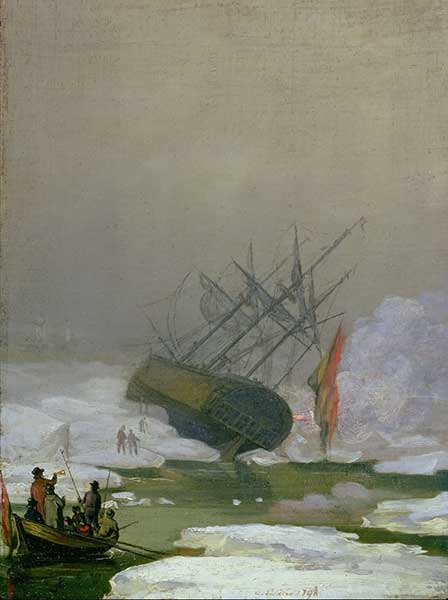
Frost-bearded, they gaze across the vast whiteness,
As light-crumbled darkness closes in.
Could one ever forget the colour green?
Aurora here are rarely seen
But fingers turn, red to blue, toes brown to black
And snap off with a curdling crack.
Leaning homeward, the beards
Come stumbling off the frozen crag
And through a twilit grunted wordless drag
Attempt to bridge the echo’s lag
Between the flexed muscle and the murmured words
A dimming memory of kindness.
.
Stephen A. Linstead
Picture Caspar Friedrich
.

The image is Caspar David Friedrich’s (1798) “Ship in the Arctic Ocean”, which predates Franklin’s ill-fated expedition by almost 50 years. Friedrich’s own brother had drowned in an ice accident, and witnessing this severely affected him. It returns as a theme in several subsequent works, notably “The Sea of Ice” [Das Eismeer] 1823-4.
Comment by Stephen Linstead on 27 September, 2025 at 7:10 amThis poem was inspired by the recent discoveries of the ships of Franklin’s Lost Expedition, stuck in Arctic Ice over 2 winters after taking a shallower route ,(1845-1848). The Erebus was discovered in 2024, and the Terror in 2018. Subsequent forensic examinations of artefacts and bodies suggest that the crew members had severely compromised immune systems, with zinc deficiency prominent, tuberculosis, contaminated food from poorly soldered cans and wild caught animals carrying botulism. They abandoned their ships to attempt to escape on foot, but were trained for a naval not a land expedition, and took with them several useless items that would have made the journey very exhausting for already weakened men. Marks on the bones of the bodies recovered are believed to confirm cannibalism.
Correction – Erebus discovered in 2014. Michael Palin did a book on it in 2018.
Comment by Stephen Linstead on 27 September, 2025 at 7:23 amWikipedia has a very informative and ip yo date site on “Franklin’s Lost Expedition” that lists the many fictional, non-fictional, creative historical, geographical and scientific treatments of the expedition including film and TV. There are useful links to related art works, including Frederic Edwin Church’s “The Icebergs” (1861). This was initially based on his own trip in 1859, but on exhibiting it in England he added a ship’s master as a tribute to Franklin. In 1864, Landseer painted his horrific “Management Proposes, God Disposes”, which features two polar bears on either side of a collapsed ship’s mast. One is dining on a human ribcage, the other is devouring a red ensign, a clear echo of Franklin.
Correction : “Man proposes, God disposes”
Comment by Stephen Linstead on 27 September, 2025 at 7:44 am